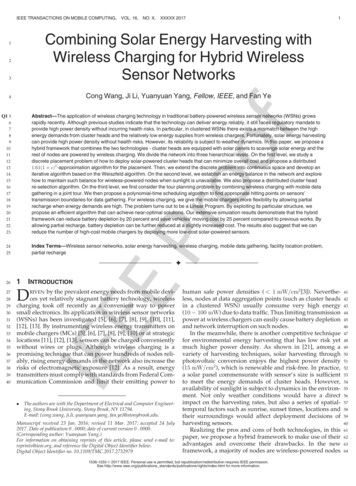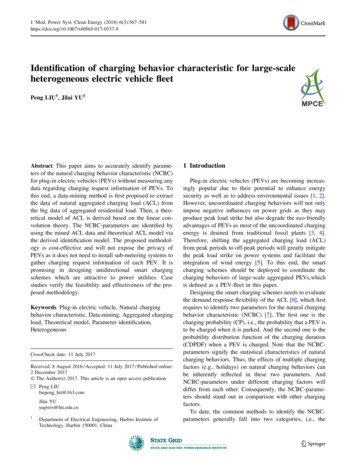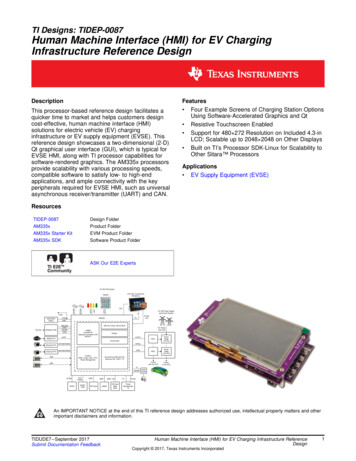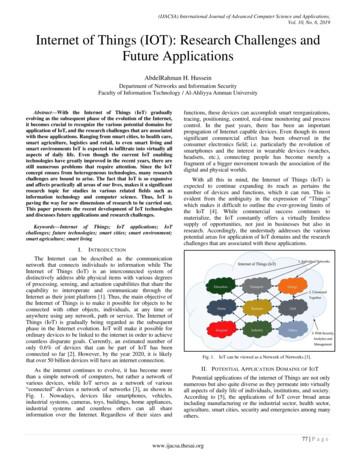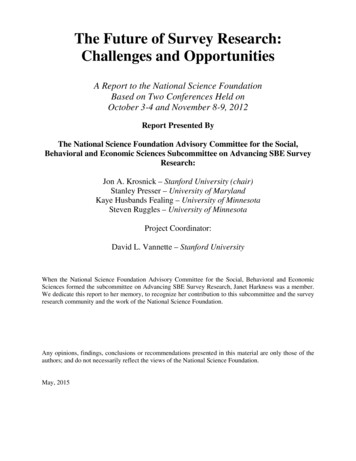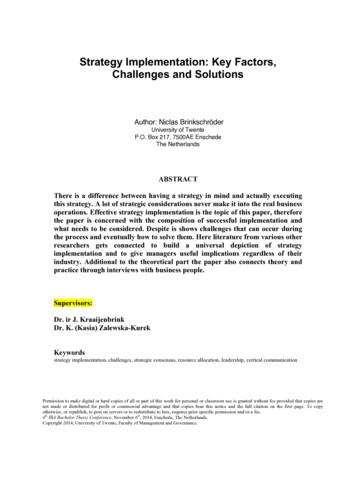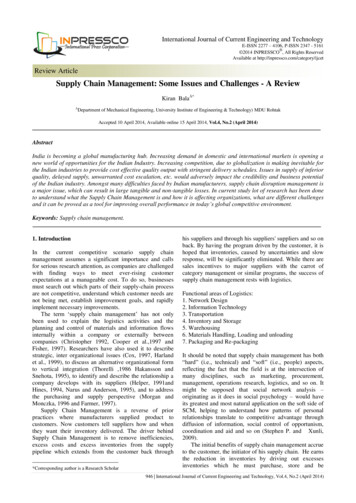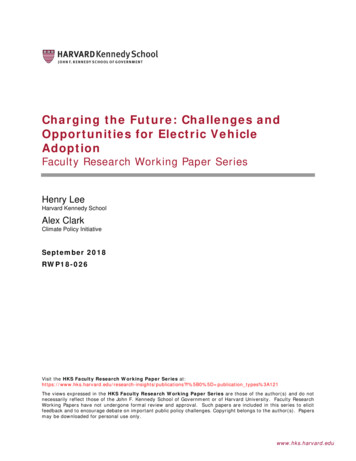
Transcription
Charging the Future: Challenges andOpportunities for Electric VehicleAdoptionFaculty Research Working Paper SeriesHenry LeeHarvard Kennedy SchoolAlex ClarkClimate Policy InitiativeSeptember 2018RWP18-026Visit the HKS Faculty Research Working Paper Series ublications?f%5B0%5D publication types%3A121The views expressed in the HKS Faculty Research Working Paper Series are those of the author(s) and do notnecessarily reflect those of the John F. Kennedy School of Government or of Harvard University. Faculty ResearchWorking Papers have not undergone formal review and approval. Such papers are included in this series to elicitfeedback and to encourage debate on important public policy challenges. Copyright belongs to the author(s). Papersmay be downloaded for personal use only.www.hks.harvard.edu
E N V I R O N M E N T A N D N AT U R A L R E S O U R C E SChargingthe FutureChallenges and Opportunitiesfor Electric Vehicle AdoptionHenry LeeAlex ClarkPA P E RAUGUST 20 1 8
Environment and Natural Resources ProgramBelfer Center for Science and International AffairsHarvard Kennedy School79 JFK StreetCambridge, MA 02138www.belfercenter.org/ENRPThe authors of this report invites use of this information for educational purposes, requiring onlythat the reproduced material clearly cite the full source: Lee, Henry, and Alex Clark, “Charging theFuture: Challenges and Opportunities for Electric Vehicle Adoption.” Belfer Center for Science andInternational Affairs, Cambridge, Mass: Harvard University, August 2018.Statements and views expressed in this report are solely those of the authors and do not implyendorsement by Harvard University, the Harvard Kennedy School, or the Belfer Center for Scienceand International Affairs.Design and layout by Andrew FaciniCover photo: A Tesla Model 3 charges using a Mobile Charger 2.0, 29 July 2017.(Steve Jurvetson/CC BY 2.0)Copyright 2018, President and Fellows of Harvard CollegePrinted in the United States of America
E N V I R O N M E N T A N D N AT U R A L R E S O U R C E SChargingthe FutureChallenges and Opportunitiesfor Electric Vehicle AdoptionHenry LeeAlex ClarkPA P E RAUGUST 20 1 8
About the ProjectThe Environment and Natural Resources Program at the Belfer Center forScience and International Affairs is at the center of the Harvard KennedySchool’s research and outreach on public policy that affects global environment quality and natural resource management. Its mandate is to conductpolicy-relevant research at the regional, national, international, and globallevel, and through its outreach initiatives to make its products available todecision-makers, scholars, and interested citizens.More information can be found on ENRP’s web site at www.belfercenter.org/enrp or from assistant director, Amanda Sardonis (amanda sardonis@hks.harvard.edu) at ENRP, Harvard Kennedy School, 79 JFK Street, Cambridge, MA 02138 USA.iiCharging the Future: Challenges and Opportunities for Electric Vehicle Adoption
About the AuthorsHenry Lee is the Jassim M. Jaidah Family Director of the Environmentand Natural Resources Program within the Belfer Center for Science andInternational Affairs at Harvard’s John F. Kennedy School of Government,Faculty Co-Chair of the Sustainability Science Program, and a Senior Lecturer in Public Policy. He also serves on the board of the school’s MiddleEast Initiative. Before joining the School in 1979, Mr. Lee spent nine yearsin Massachusetts state government as Director of the State’s Energy Officeand Special Assistant to the Governor for environmental policy. He hasserved on numerous state, federal, and private boards, and advisory committees on both energy and environmental issues. His recent researchinterests focus on energy and transportation, China’s energy policy, andpublic infrastructure projects in developing countries.Alex Clark is a climate finance analyst at the Climate Policy Initiative, covering a range of topics including low-carbon transport, blended financeand tracking of climate finance flows. He is Senior Advisor to the Sustainable Development Solutions Network - Youth, and was the 2016-17 HenryFellow at the Harvard Graduate School of Arts and Sciences. He hold anMSc in Global Governance and Diplomacy from Oxford University, anda BA(Hons) in Politics, Philosophy and Economics from the University ofWarwick. Alex provides informal coordination support to the Galvanizingthe Groundswell of Climate Actions initiative, supporting non-state andsubnational climate action efforts globally. He is also an Associate Fellow ofthe Royal Commonwealth Society.Belfer Center for Science and International Affairs Harvard Kennedy Schooliii
AcknowledgementsThis paper benefited from the assistance on data access and analysis fromWilliam Hogan, Raymond Plank Professor of Global Energy Policy at theHarvard Kennedy School, and Mauricio Salles, Laboratory of AdvancedElectric Grids - LGrid, Polytechnic School, University of São Paulo, SãoPaulo 05508-010, Brazil, and from data collected by PlugShare (formerlyRecargo). The authors are particularly thankful to the following individualsfor their insights and contributions:Will CarryAbdellah CherkaouiLarry DickermanRyan HartyPaul HibbardSteve KosowskiNick LembachKevin MillerSalim MorsyMike NicholasTerry O’DayParina ParikhQinyu QiaoJonathan RaabMichael ReplogleRobert ScholerCal SilcoxMark SimonPatrick SmithDean TaylorNew York City Department of TransportationVoltaLandis GyrAmerican Honda Motor CompanyAnalysis GroupKia Motors AmericaRecargoChargePointBloomberg New Energy FinanceInternational Council on Clean TransportationEVGoSan Diego Gas & ElectricHarvard Kennedy SchoolRaab AssociatesNew York City Department of TransportationKia Motors AmericaPacific Gas & ElectricNew York City Department of TransportationNew York City Department of TransportationSouthern California EdisonNone of the individuals listed have any responsibility for the content of thispaper, nor do they necessarily endorse its findings. We would also like toexpress our appreciation to Julie Gardella for her assistance in formattingand preparing numerous drafts of this paper.Belfer Center for Science and International Affairs Harvard Kennedy Schoolv
Table of ContentsExecutive Summary.1Introduction. 41. Battery Technology. 61.1Challenges to Wider Deployment. 91.2Subsidies . 101.3Lifetime Costs . 112. Charging Infrastructure.172.1The Charging Challenge. 182.1.12.22.32.4Types of EV Charging Equipment. 19Understanding Charging Economics. 242.2.1Fixed Costs.242.2.2Variable Energy Costs.28Modeling Charging Economics.342.3.1Results of the Analysis. 362.3.2Commercial Charging. 382.3.3Pricing models. 452.3.4Summary.47Load Management for Large-Scale EV Integration.483. Conclusion. 524. References.54Appendices. 59A.1Lifetime EV Cost Modeling. 59A.2Charging Infrastructure Base Case Model Assumptions.60Belfer Center for Science and International Affairs Harvard Kennedy Schoolvii
Cover ImageA Tesla Model 3 charges using a Mobile Charger 2.0, 29 July 2017.
Executive SummaryElectric vehicles (EVs) have advanced significantly this decade, owingin part to decreasing battery costs. Yet EVs remain more costly thangasoline fueled vehicles over their useful life. This paper analyzes theadditional advances that will be needed, if electric vehicles are to significantly penetrate the passenger vehicle fleet.Battery PricesCell costs have plummeted to 145 per kWh or lower, and areexpected to continue falling with technological improvements andreturns to large-scale production. While cells are only one componentof the cost of an installed battery, the cost of installed batteries hasdeclined from around 1,000 per kWh in 2010 to an estimated 250350 per kWh in 2018. Total battery costs are falling more slowly, asconsumers demand EVs with longer ranges and thus larger batteries.Meanwhile, governments are finding it increasingly difficult to fiscallyjustify large subsidies to attract buyers.Will Declining Battery Costs Make EVs Competitive?This paper compares the lifetime costs of battery-only cars (BEVs),plug-in hybrids (PHEV) and gasoline-fueled internal combustion-engined vehicles (ICE), using a range of gasoline prices, discount rates,and battery costs. The PHEV is more expensive than the ICE inalmost all scenarios, while the BEV is robustly cost-competitive, onceinstalled battery prices reach 200- 250 per kWh. Hence, furtherreductions in battery costs will still be needed for BEVs to be a viablealternative to ICEs.The paper compares the lifetime costs of the Chevrolet Bolt BEV tothe costs of an equivalent PHEV and ICE, using a range of gasolineprices, discount rates, and battery costs. The PHEV is more expensiveBelfer Center for Science and International Affairs Harvard Kennedy School1
than the ICE in almost all scenarios, while the BEV is cost-competitiveonce battery prices reach 200- 250 per kWh.Will Charging Infrastructure Support EV Adoption?Commercial success for EVs will require installing charging infrastructurethat is accessible, easy to use, and relatively inexpensive—whether at homeor in public locations. The form this infrastructure will take is still uncertain, with a range of charging technologies currently available and moreexpected to emerge over the next five years. The current range of equipment spans slower alternating current (AC) chargers best suited to homeor office locations and short trips (Level 1-2 in this paper), and much fasterdirect current fast chargers (DCFC) for rapid refueling in public locations,best suited for recharging on longer journeys (Level 3-5). The time takento add 100 miles of range varies from 26 hours for the slowest AC charger,to six minutes for the fastest DCFC charger—still far slower than the 300miles-per-minute enjoyed by a 30 mile-per-gallon ICE.The costs of charging infrastructure are both fixed (installation, utilityservice, transformers, and equipment) and variable (electricity charges).For chargers on commercial electricity tariffs, demand charges can dominate operating costs. As a result, the total cost of power from fast chargingstations is higher than slower residential chargers unless the former canachieve sufficiently high utilization rates.Modeling different types of charging infrastructure and comparing themwith the operating costs of an ICE suggests that simple home chargingis competitive with today’s more efficient gasoline cars and could be significantly cheaper if a time-of-use electricity tariff, with lower prices inoff-peak periods, is in place. More powerful home charging is sensitive tocapital costs, but is competitive with moderately efficient ICEs and substantially cheaper under a time-of-use tariff. For commercial chargers(Level 3-5), the price of electricity required for investment in the systemto break even falls sharply at progressively higher utilization rates. At 30%utilization, all variants are cheaper than fueling an average ICE, and at 40%utilization, they are competitive with an efficient ICE.2Charging the Future: Challenges and Opportunities for Electric Vehicle Adoption
At current levels of utilization (optimistically, 10%), commercial chargersare almost universally not economically profitable, suggesting a significant,sustained increase in demand will be needed for commercial charginginfrastructure to deliver financial returns, and compete with both ICEs andcheaper residential charging.Managing additional power demand from EVs is both a challenge andan opportunity for distribution utilities. High concentration of EV homecharging during peak periods can overload local transformers. Utilitiesmay have to procure additional peak capacity, unless they are able to shiftdemand to off-peak periods. Time-of-use electricity pricing, along withsmart metering, have already been deployed in some states to incentivize off-peak charging and manage peak loads, respectively. It is unclearwhether they will be sufficient to offset demand increases. Vehicle-to-gridtechnology, allowing EVs to serve as mobile electricity storage units, couldcomplement these efforts but will need adequate incentives, which are notpresently available. Overall, electricity tariff reforms will be essential, iftoday’s power systems will be able to serve the additional demand from thesignificant deployment of electric vehicles.Belfer Center for Science and International Affairs Harvard Kennedy School3
IntroductionOver the past decade there has been a growing interest, bordering onenthusiasm, for electric vehicles. Is the American motorist on the cuspof replacing gasoline-powered cars with electric versions? Will gasolinestations be superseded by fast charging stations? Will the transportationsector of the future be electrified? These questions are at the core of theenergy and transport debates. Governments have enacted subsidy programs, supported the installation of a charging infrastructure, and arestarting to develop regulatory initiatives to support and manage an electricvehicle fleet. In fact, some governments—including the United Kingdomand France—have announced that they will not permit the sale of new fossil-fueled automobiles after 2040.1 The car manufacturers that were initiallyskeptical about electric vehicles are now committing billions of dollars totheir production. By 2022 there will be 127 different fully battery-electriccar models available for purchase in the United States.2Is this euphoria justified by the state of the technology and by economicand financial realities? Six years ago, a Harvard paper attempted to addressthis question.3 Its conclusion was that under most business-as-usual scenarios, efficient fossil-fueled automobiles would continue to have a cost advantage over electric vehicles. At the time, the future of electric vehicles depended largely on a combination of high government subsidies, extremelyhigh gasoline prices (over 4.50 per gallon), and dramatic improvements inbattery technology. Today, the outlook is more positive, but several of thesame unresolved questions remain. Will battery powered electric vehiclesbe competitive with conventional gasoline-fueled vehicles in the next fiveto ten years? Will a cost-effective charging infrastructure emerge? What arethe economic and financial challenges that must be overcome?41Ryan, C. and J. Shankleman. 26 July 2017. “U.K. Joins France, Says Goodbye to Fossil-Fuel Cars by2040”. Bloomberg. telegraph2Naughton, K. 19 December 2017. “The Near Future of Electric Cars: Many Models, Few Buyers”.Bloomberg. uyers3See Lee, H. and G. Lovellette. 2011. “Will Electric Cars Transform the U.S. Market?” Harvard Kennedy School Faculty Research Working Paper Series RWP11-032. ile.aspx?Id 715Charging the Future: Challenges and Opportunities for Electric Vehicle Adoption
First, over the past six years, battery costs have fallen significantly, but thesize of battery packs has increased. In other words, in the course of addressing range anxiety, the total cost of an EV battery pack has declinedmore slowly than the cost per kilowatt-hour (kWh). As a result, installedbattery costs continue to be a barrier to widespread consumer acceptance.This paper reviews the status of these costs and the levels that must bereached if electric cars are to become cost-effective alternatives.Second, while battery costs have attracted the interest and the pocketbooks of both car manufacturers and the electronics industry (Samsung,LG, Panasonic etc.), the challenges around designing and operating a financially viable charging infrastructure to serve EV batteries remain. Thereare different types of home-charging equipment, and multiple commercial-charging station configurations, with no clear winner in the currentmarket. Who will develop a commercially profitable plan to charge theelectric cars of the future—the electric utility companies? The automobilemanufacturers? The equipment manufacturers? Or third-party investors?None of these candidates has yet to implement a sustainable long-termbusiness plan. The good news is that manufactures, utilities and otherparties are moving quickly to develop inter and intra-city charging options,but significant regulatory and financial complexities may retard widespreadeconomically sustainable deployment. This paper examines these complexities, and how they affect the cost of fueling and operating an electricvehicle.Belfer Center for Science and International Affairs Harvard Kennedy School5
1. Battery TechnologyImprovements in battery technology over the past six years have beenimpressive. Today’s battery cells have higher energy densities and are muchless expensive on a per kWh basis than they were just a few years ago.Lithium-ion (Li-ion) cells enjoy the bulk of investment, and remain thepreferred technology for LG Chem, Panasonic, and Samsung, the threelargest producers. Lithium-metal technologies with much higher energydensities are in development, but currently lack the production scale andestablished supply chain advantages of Li-ion.4Verifiable information on battery costs is difficult to obtain, owing to bothintense commercial sensitivity and confusion over the definition of “battery”—which can apply to the cost of individual cells, the battery pack, orthe battery pack once installed in the vehicle itself, or indeed the final costto the consumer once any manufacturer markup is applied. These distinctions are explained below, and unless otherwise stated, “battery costs” insubsequent sections of this paper refer to the total cost to the consumer.The sharp downward trend in the cost of Li-ion cells, however, is clear.From a baseline of about 1,000 per kWh for an installed battery. Cellmanufacturing costs have declined about 70% since 2010 due primarily toeconomies of scale.5 This holds across different configurations and chemical compositions, and is the largest contributor to observed cost declines,with an average of 8% cost reduction for a doubling in volume every yearsince 2010.6 Compounded from 2010-2015, this equates to a 35% realdecline in cost due to economies of scale, accounting for almost half ofthe total cost reductions seen since 2010. Nykvist and Nilsson’s (2015)study concurs with this finding, attributing 30% of cost reductions from2013-2017 to economies of scale, and the remainder to declines in material64Samsung, among others, has been developing graphene-based battery technologies. Despiterecent research advances, the technology is still focused on mobile device applications. It remainssome distance from commercialization in any form, and further away from deployment at the scalerequired for a car battery. Jung-a, S. 27 November 2017. “Samsung hails “graphene ball” batterysuccess”. Financial Times. -d9c0a5c8d5c95Boston Consulting Group. 2010. “Batteries for Electric Cars: Challenges, Opportunities and theOutlook to 2020.” Boston, MA: Boston Consulting Group.6Faguy, P. 2015. “Overview of the DoE Advanced Battery R&D Program”. U.S. Department of /f23/es000 faguy 2015 o.pdfCharging the Future: Challenges and Opportunities for Electric Vehicle Adoption
costs and learning rates, with an estimated combined annual cost decline(including both learning rate and returns to scale) of 12-14%.7As noted already, cell costs are only a part of the total installed cost of thebattery. Using available information on battery sales to manufacturers,McKinsey’s 2017 Electrifying Insights report implies an underlying Li-ioncell cost of approximately 150 per kWh at the end of 2016, and an additional cost of roughly 70-100 per kWh to convert cells into battery packs.McKinsey’s figures correspond with the more optimistic end of projections from earlier studies, citing an installed battery pack cost (to the carmanufacturer) of 227 per kWh in 2016.8 This is roughly in line with U.S.Department of Energy trend estimates that put battery pack costs for 14kWh plug-in hybrid EVs (PHEVs) at 289 per kWh in 2015, with potential for economies of scale alone to push this down further to 200 perkWh.9 By McKinsey’s estimate, battery pack costs are projected to fall to 190 per kWh by 2020.10 The McKinsey report implies that these decreaseswill come primarily as a result of further technological advances in theproduction of the cells themselves, rather than reductions in capital costsstemming from scaled-up efficiency, but the report does not explain wherespecifically these advances will be made.The International Energy Agency’s 2018 Global Electric Vehicle Outlookestimates cell costs at 145 per kWh, and gives its range of estimates forinstalled battery pack costs at 155- 360 per kWh, depending heavily onproduction scale and battery size. Their mid-range estimate of the totalcost to the consumer is 274 per kWh, based on comparing pricing ofmodels with ICE and BEV powertrains.11 This in turn implies the difference between cell cost and total cost to the consumer is in the vicinity of 130 per kWh. Given the inherent uncertainties in these estimates, weassume this difference is between 100- 200 per kWh, implying a totalcost to the consumer of 245- 345 per kWh (see Table 1.1). This additionalcost reflects an additional manufacturer mark-up over the cost of materials7Nykvist, B. and M. Nilsson. 2015. “Rapidly falling costs of battery packs for electric vehicles”. NatureClimate Change 5: 329-332. doi:10.1038/nclimate2564.8McKinsey & Company. 2017. “Electrifying Insights - How auto makers can drive electrified vehiclesales and profitability.” New York, NY: McKinsey & Company.9Faguy, P. 2015. “Overview of the DoE Advanced Battery R&D Program.”10McKinsey & Company. 2017. “Electrifying Insights.”11International Energy Agency. Global EV Outlook 2018: Towards cross-modal electrification. p.66.Belfer Center for Science and International Affairs Harvard Kennedy School7
and assembly to recover capital investment and research and development,and to achieve a rate of return. In the latter case, there may be substantialvariation across manufacturers, depending on whether their electric vehicle sales are intended to be profit-making. Assuming that the existing priceranges reflect some form of manufacturer discount to boost demand, wecontend that financially sustainable pricing is currently in the 300- 400per kWh range.12Table 1.1Battery cost estimates across stages of productionStage of ProductionEstimated Cost per kWhCell costPurchasing Lithium-ion cells from the cellmanufacturer 145Pack assemblyArranging cells into a battery packPack covering and preparation 215-245Wrapping battery in protective materialsready for installation(combined cost implied from differencebetween cell cost and installed cost, usingMcKinsey 70- 100 estimate)Installed packInstallation into the vehicle. Includes wiring,circuitry and invertersTotal cost to consumer 245-345Price markup between capital cost to manufacturer and price charged to consumer.Covers additional labor and capital costs toOEM.(total cost implied from difference betweencell cost and total cost to consumer, using a 100- 200 estimate implied from IEA 274mid-range figure)Battery pack prices are generally difficult to ascertain with any precisionand the ultimate cost to the consumer depends on supply chain dynamics,manufacturer mark-up, and scale. In Table 1.1, we break down estimatesof the various components of battery costs. While the figures for cell cost,installed cost, and final cost (including markup) are roughly consistent,the largest information gap is in the stages between purchasing cells andinstalling the battery pack into an EV drivetrain (including pack assembly,covering it with protective material, wiring, circuitry, safety measures, andan AC/DC inverter). Allowing for a wide margin of error, it is reasonable128As noted below, the Chevrolet Bolt is an example of a loss-making vehicle. It is often unclear inthese cases whether discounted pricing is applied to the batteries or the vehicle as a whole, andwhether it is part of a strategy to stimulate demand, or to avoid penalties for non-compliance withclean vehicle regulations.Charging the Future: Challenges and Opportunities for Electric Vehicle Adoption
to conclude that the total cost of an EV battery by the end of 2017 was inthe region of 250- 350 per kWh, and likely to fall as competitive pressurebuilds, technology improves, and large-scale production continues to produce returns to scale.1.1 Challenges to Wider DeploymentThe declining per-kWh cost of batteries is happening at the same timethat battery pack sizes are increasing. In search of increased range, manufacturers are augmenting the size of battery packs on new models. Thebase-model Nissan Leaf powertrain grew from 24 kWh to 30 kWh for thefirst generation, then to 40 kWh for the second generation (announced inSeptember 2017),13 while Tesla’s Model S base model has grown from offering 60 kWh, to 70 kWh, with a 100 kWh model released in August 2016.14The delicate balance between using larger batteries to improve performance and range, and keeping costs affordable, is not lost on an industry inwhich “unfavorable battery economics will remain a profitability barrier forthe next two to three product cycles”.15Nonetheless, OEMs are investing heavily in building up EV productioncapacity. In addition to offering a PHEV version of every model it makes,Volkswagen Group expects to offer 30 battery-only electric vehicles (BEVs)by 2025, making up 25% of all new sales,16 while Ford plans 13 BEVmodels by 2022. The Chinese government has a target of 8% of all salesbeing BEVs or PHEVs in 2018, and a coalition of eight U.S. states, including California, is aiming for a total of 3.3 million EVs on their roads by2025.17 In Norway, BEVs and PHEVs accounted for a third of new sales in2016, with a target of 400,000 BEVs by 2020. Norway’s success is at least13Nissan USA. 2017. “Build your 2018 Nissan Leaf.” onfigure/14Lambert, F. 2016. “Tesla’s new Model S P100D is not only quick, it’s the first all-electric car withover 300 miles of range.” Electrek. nsey & Company. 2017. “Electrifying Insights.”16Campbell, P. 26 July 2016. “Electric cars see range, battery and ease of charging as barriersto mass adoption.” Financial Times. c11776a5124d17The Economist. 18 February 2017. “Volts wagons: Electric cars are set to arrive far more speedilythan anticipated.”Belfer Center for Science and International Affairs Harvard Kennedy School9
partly due to exceptionally low hydroelectric power costs for charging, andeffective policy measures offering a host of additional benefits to EV drivers (including free parking and charging) and exemptions from purchasetaxes that typically double the cost of a gasoline powered vehicle.18Meeting this expected EV demand will require an unprecedented build-upof battery procurement capacity and capital investment, with the transitionlikely to be loss-making in the short term as established OEMs shift capital and labor resources rapidly towards EV mass-production. U.S. bankMorgan Stanley projects Volkswagen’s entire automobile business may beloss-making from 2025-2028 as a consequence.19 Affordable supplies ofcritical materials for battery manufacturing, notably cobalt, may be placedunder pressure, while assembly plants will require large capital investmentsto scale up EV production sufficiently.201.2 SubsidiesThe U.S. federal credit instituted by the Obama Administration of up to 7,500 per car, depending on the capacity of the battery, is valid for upto 200,000 PHEVs or BEVs sold and registered with the Department ofTransport by each independent manufacturer, regardless of model. Fromthe 200,000th vehicle onwards, the program is p
gined vehicles (ICE), using a range of gasoline prices, discount rates, and battery costs. The PHEV is more expensive than the ICE in almost all scenarios, while the BEV is robustly cost-competitive, once installed battery prices reach 200- 250 per kWh. Hence, further reductions in b
